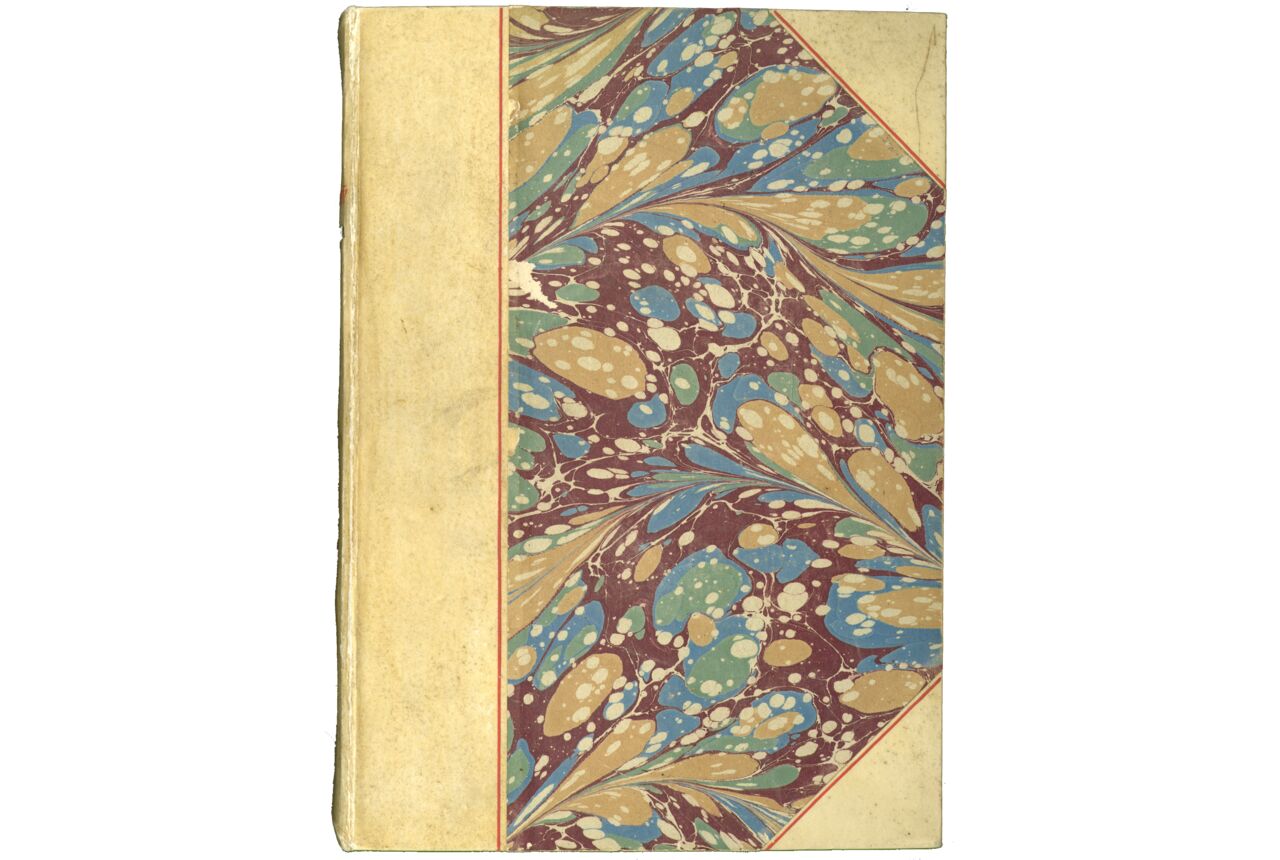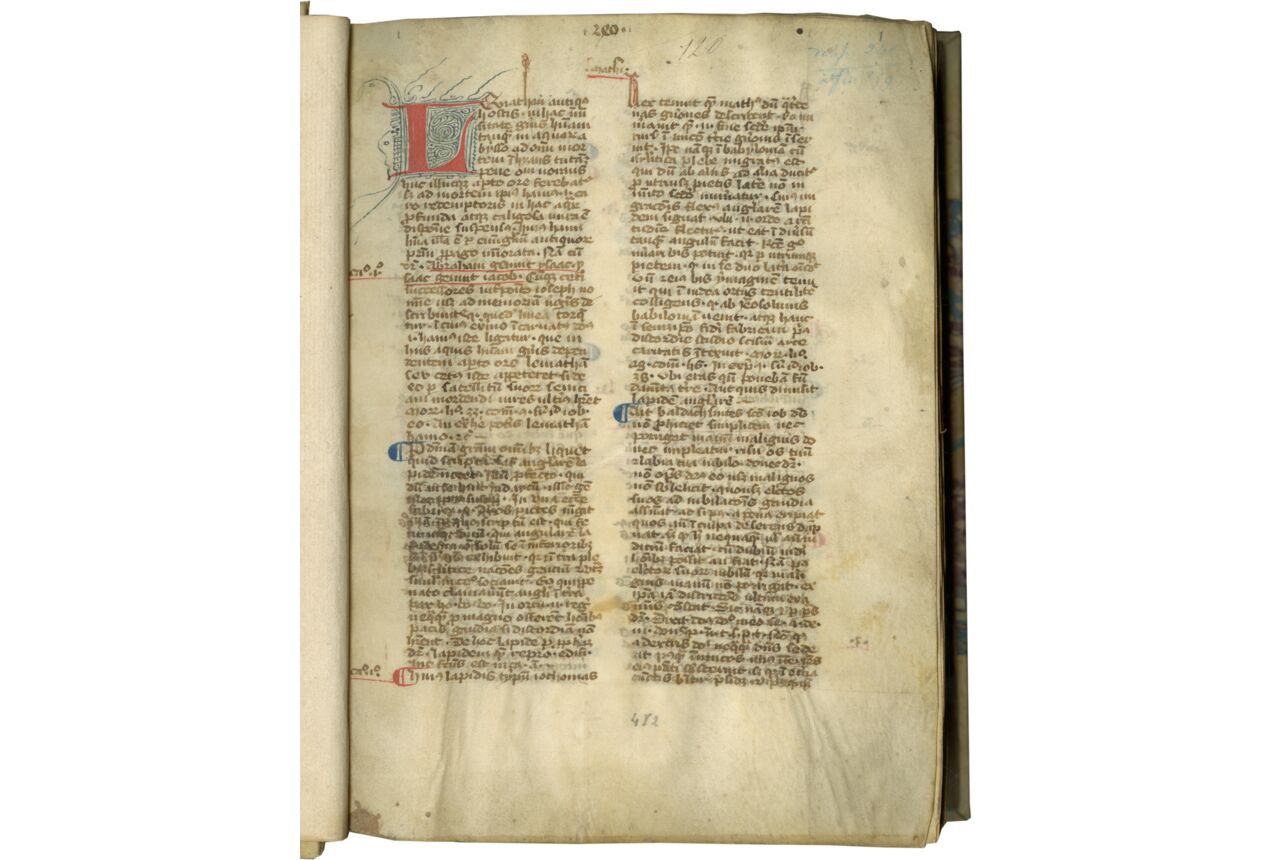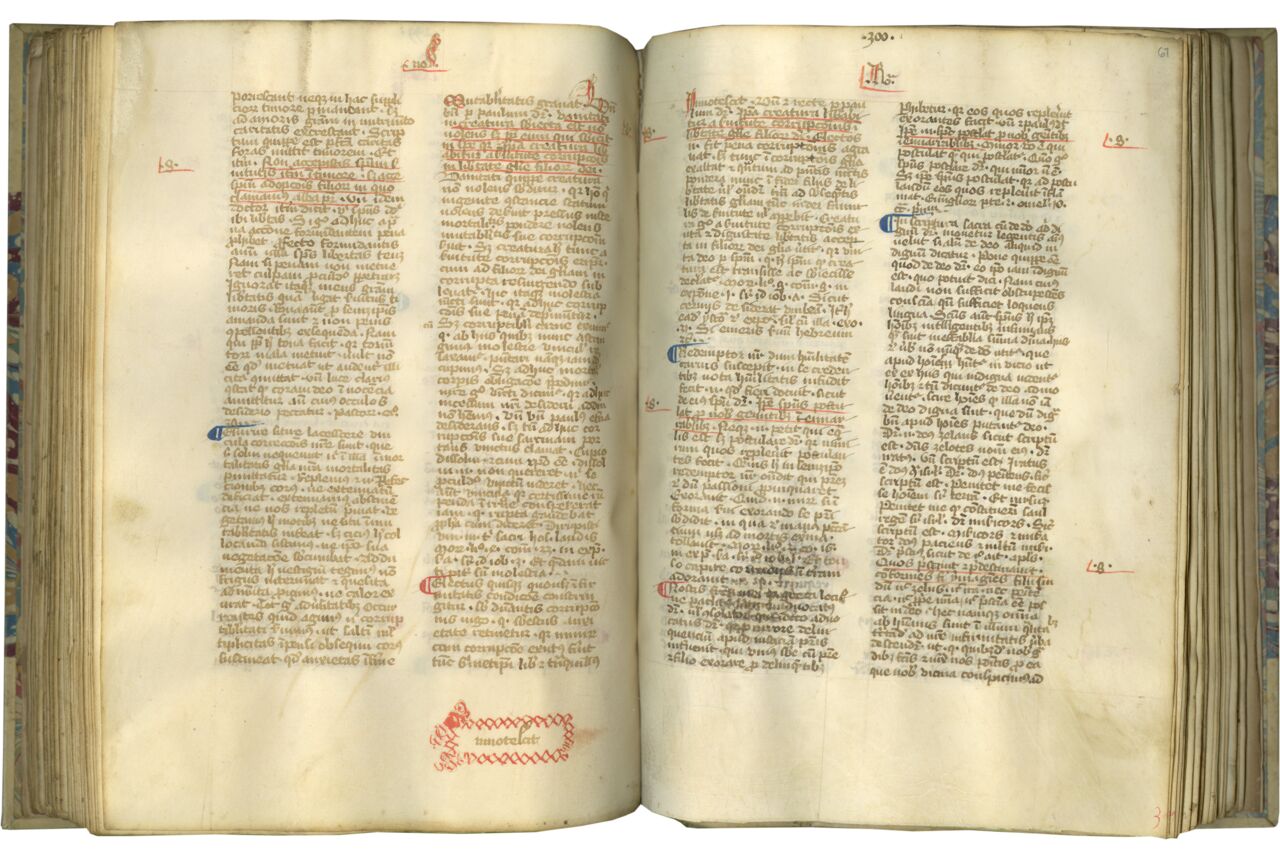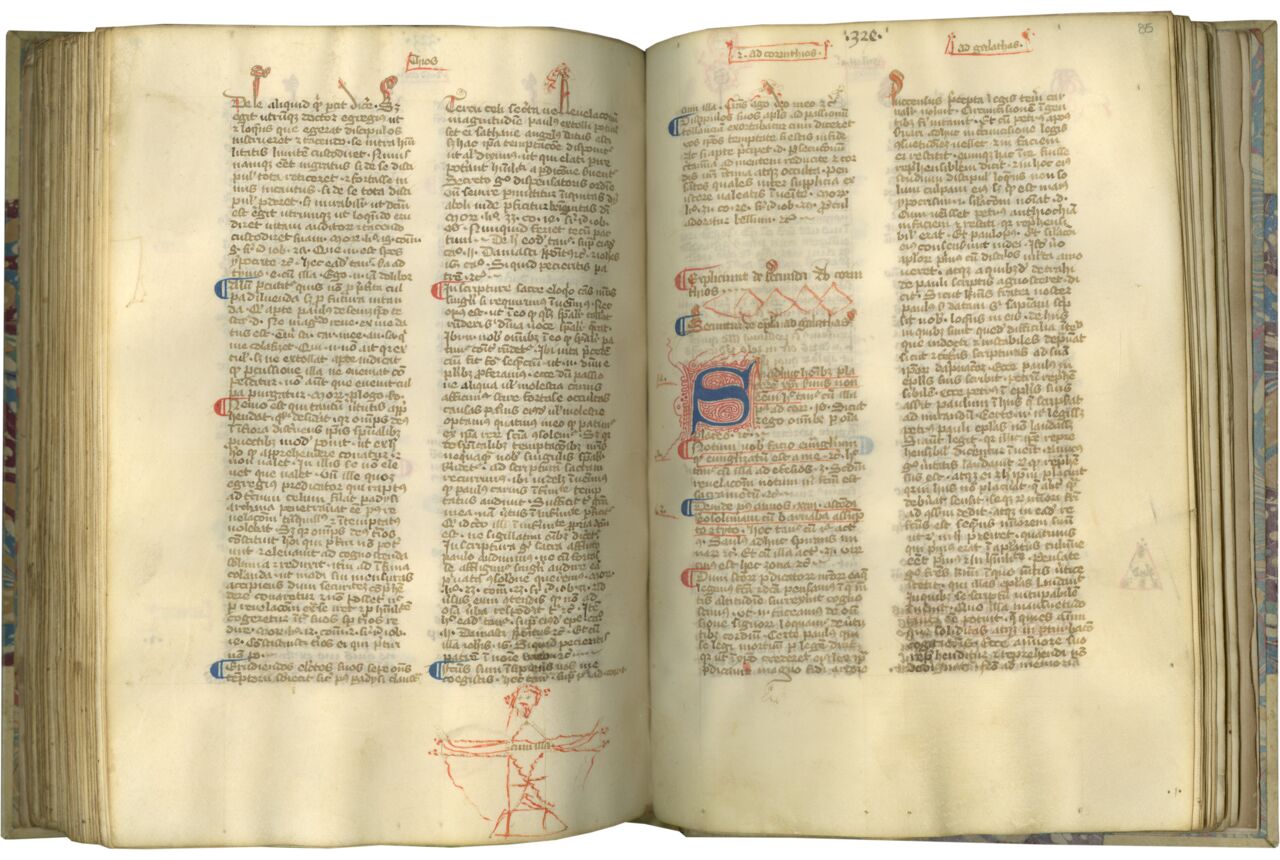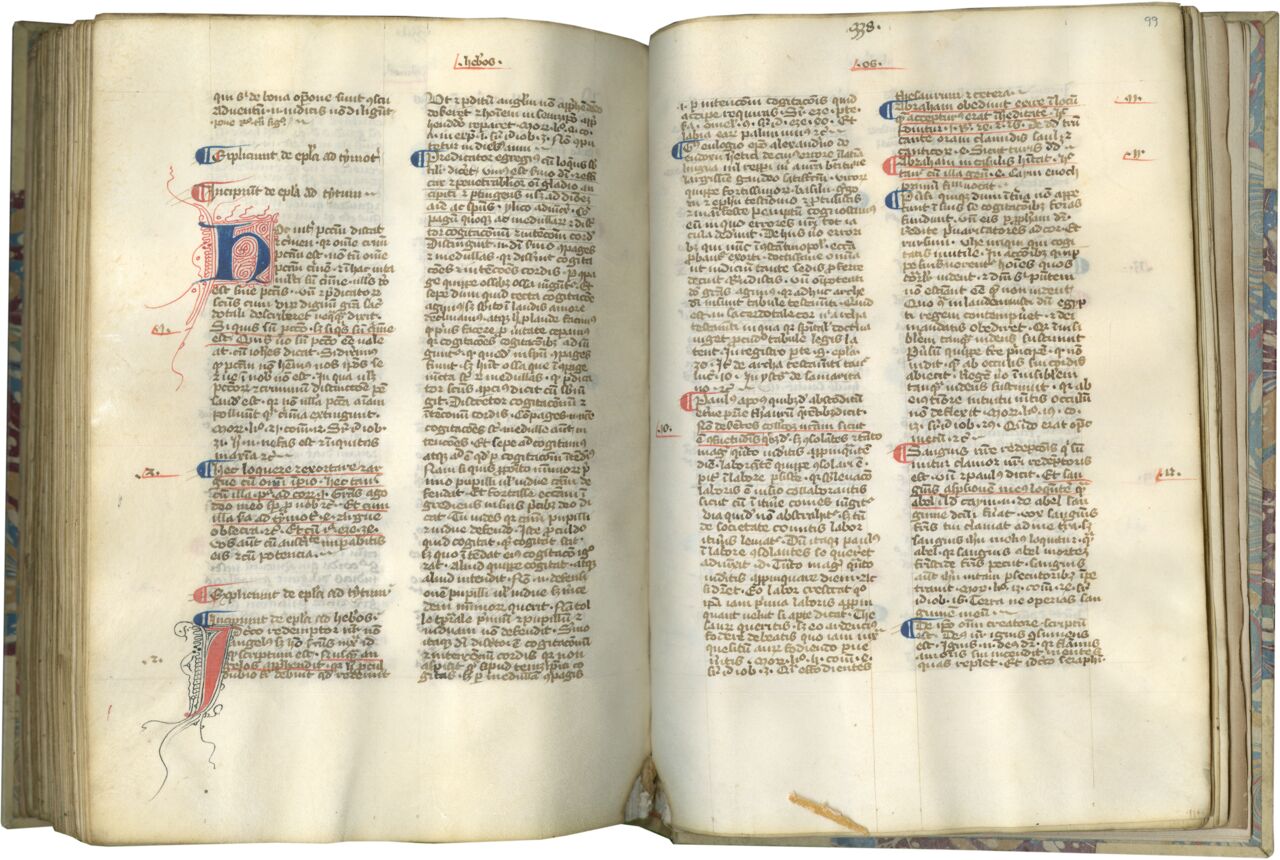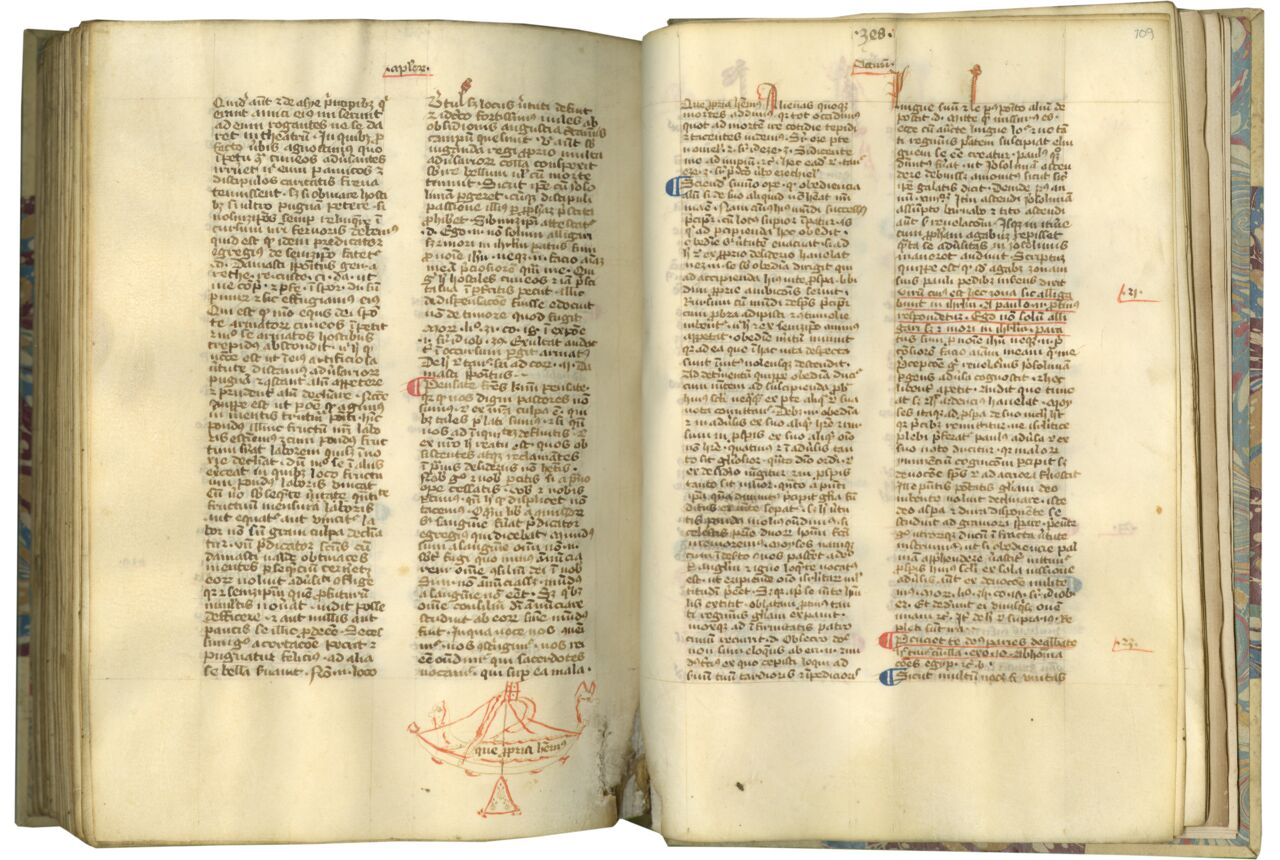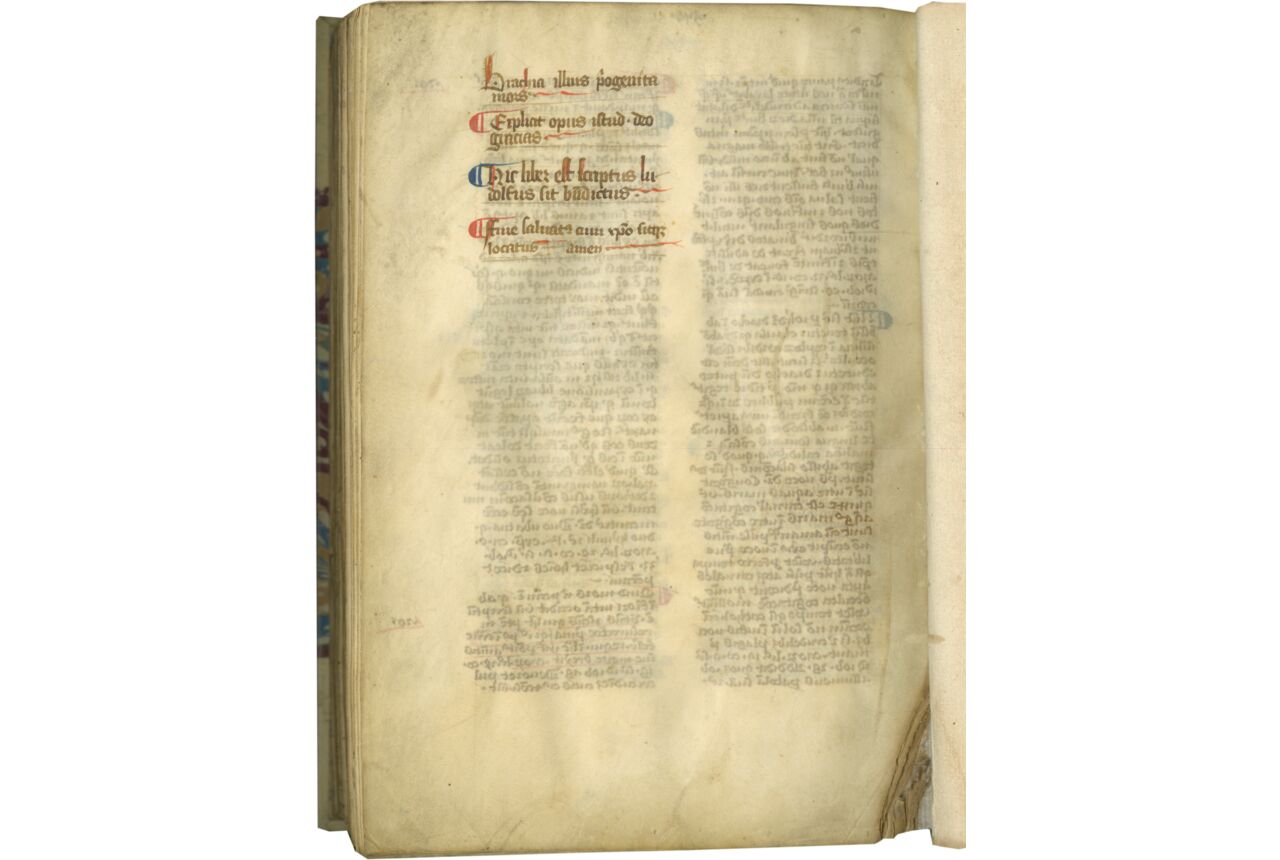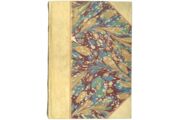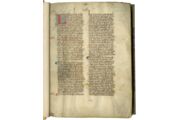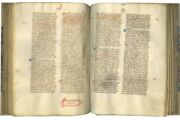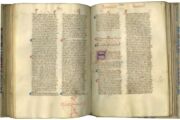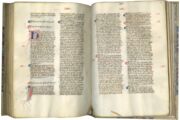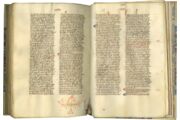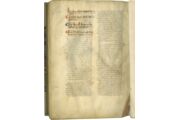iv (modern paper) + 120 + iv (modern paper) folios on parchment, late medieval Arabic numeral foliation in black ink at center top of rectos beginning at 240-359, modern pencil foliation at top recto corners, 1-120, complete (i-x12) but incorrectly arranged [correctly ff. 1-87v, ff. 112-117v, ff. 94-111v, ff. 88-93v, ff. 118-120 according to medieval notes], catchwords illustrated in red and brown ink (e.g. Christ on the Cross, f. 84v; a ship with human heads at bow and stern, f. 108v), occasional and partial red ink quire signatures, ruled in ink in two columns of 48-50 lines (justification 171 x 115 mm.), written by a single scribe identifying himself as Ludolfus (f. 120v) in a university bookhand, reading aids throughout including red underlining of biblical lemmata, some majuscules touched with red, rubrics in Gothic display script, running titles, alternating red and blue paraphs, scrolling cadels at top lines sometimes in human and animal forms (e.g. dog and rabbit on f. 101, three-hand maniculae on f. 118), capitals in ornamental pen strokes touched in red (and occasionally with figures, such as sheep head on ff. 63v and 87, and deer heads on ff. 19v and 59v picked out in penwork), numerous red and blue/black penwork initials of five to seven lines, some small spots and parchment discoloration occasionally clouding text, most prominent in first quire and resulting in minor text loss on ff. 1, 24v, 28v, and 61, several original holes in parchment once stitched, rodent damage to bottom inner corner of last two quires, minor cockling of leaves due to tight binding, but in otherwise good condition. Nineteenth-century binding of marbled boards and doublures, parchment covering corners and spine, spine title reading “IN NOV[UM] I. C. TESTAMENTU[M] COMMENTARIA MSS” in red and black with filigreed decoration in red, some chipping on cover, edges, and hinges, staining on front flyleaves and some ink transfer to flyleaves adjacent to bookblock, overall in good condition. Dimensions 240 x 170 mm.
A New Testament commentary, Jacobus Folquerius’s Viridarium Gregoriana, mined from many of Gregory the Great’s works, drawing occasionally on Alulfus of Tournai’s Gregorialis. The scribe, who identifies himself as Ludolfus, produced his rare copy around 1350 in Southwest Flanders or Hainaut. The text is known in only three other manuscripts; this copy was, until now, apparently unknown, and is certainly the only of its kind on the market. As a witness to an unedited, and indeed largely unstudied, text used for sermon-writing, this manuscript warrants deeper study.
Provenance
1. Based on the script, this manuscript was copied c. 1350 by a scribe trained in Southwest Flanders or Hainaut (Tournai?). The parchment’s texture and penwork initials are also consistent with this region. The scribe, moreover, names himself on the final folio: “Hic liber est scriptus ludolfus sit benedictus.” Ludolfus is otherwise unknown. The Germanic name Ludolfus, coupled with the manuscript’s northwestern physical features, is consistent with production in this region.
Although complete, the manuscript’s text is out of order, and was so in its prior binding. It may have been copied from a misbound exemplar. The text’s correct order is indicated in short early fifteenth-century notes below the text on ff. 87v, 93v, 111v, and 117v. The same hand may have added the Arabic numeral foliation–the notes utilize these numbers–to guide the reader through the disordered manuscript. This foliation, spanning 240-359, suggests that the manuscript was probably the final volume in a set of two (the first containing 239 folios) or even three (each spanning around 120 folios) including commentary on the full Bible. No further evidence of use is apparent.
2. There are three nineteenth-century notes on f. 1: in the upper margin, “120” in black ink and in blue pencil, “before 240 / after 359” (the number of folios and span of foliation, respectively); and at the bottom, “412” (presumably a former shelfmark). A small slip of paper with an erroneous note, probably by the same hand as f. 1’s “120,” is loosely inserted at back. It reads “Ludolphi. In Novum Testamentatum [sic] Commentaria – | Manuscrit du XVe Siècle | Reliure Parchemin grand in 8o.” An earlier auction record indicates this manuscript was previously in a Bordeaux private collection, although the blue pencil note in English suggests an interruption in French ownership.
Text
ff. 1-23, incipit, “Leviathan antiquus hostis, in hac immensitate generis humani tanquam in aquarum abysso ad omnium mortem … Abraham genuit ysaac, ysaac genuit iacob. Cumque certi successores interposito ioseph nomine … [f. 23] Sumus quia seductor ille dixit post tres dies resurgam. Quanta ergo nos peccatores a lingua vel manibus … In registro parte ii epistola 39,” Expliciunt de evangelio mathei;
Jacobus Folquerius, Viridarium Gregorianum, on selected verses of Matthew (unedited; compare Toulouse, BM, 187, ff. 175v-192v). The commentary begins with passages lifted from Gregory’s Expositio Evangelii secundum Matthaeum (PL 79, col. 1141 A) and ends with a line from his letter of comfort to the Roman patrician Theoctista, identified here as letter 39 of his Registrum (letter 45 in PL 77, col. 1159 A).
Direct references to Gregory’s Moralia, Registrum, Dialogi, Regula pastoralis and various Homilies on the Old and New Testament are found throughout the manuscript. He is frequently referred to as predicator egregious (illustrious preacher). While extracts are not always attributed to an individual work, the text often directs the reader to consult specific works in their entirety when relevant to the book or topic discussed.
ff. 23-28v, Incipiunt de marcho, incipit, “Locustarum nostrae in scriptura quam iudicorum populus designat … [f. 28v] Euntes in mundum universum praedicate evangelium omni creaturae. Omnium universaliam creaturam solum inter hominem voluit … Simile potius omelius 9 secundae protis evangeliorum etc.,” Expliciunt de evangelio marci;
Jacobus Folquerius, Viridarium Gregorianum, on selected verses of Mark (unedited; compare Toulouse, BM, 187, ff. 192v-196v). Arranged in the same manner as the previous section, relying heavily on Gregory the Great. The mention of locusts at the incipit refers directly to Apocalypse, but locusts also feature in Gregory’s Moralia in Iob (see in particular Book 31, §45-50, PL 76, col. 598-600). The closing passage is taken from his Homily 29 on the Gospels (PL 76, col. 1214 B), with reference to yet another homily in the explicit.
ff. 28v-45, Incipiunt de evangelio luce, incipit, “Ipse preibit [sic: praecedet] ante illum in spiritu et virtute helye [=Elias] … Scriptum quippe est. Cum factus esset Iesus annorum xii et cetera. Require sumus hic et pastoris capitulo eius,” Expliciunt yistorie de lucha et cetera;
Jacobus Folquerius, Viridarium Gregorianum, on selected verses of Luke (unedited; compare Toulouse, BM, 187, ff. 196v-209). This section begins with Luke 1:17, followed by an excerpt on the nature of angels from Gregory’s Homily 34 on the Gospels (PL 76, col. 1250 C). The final excerpt, commenting on Luke 24:46, is found in Gregory’s Regula pastoralis, Book III, Ch. 25 (PL 79, col. 1203 D).
ff. 45-57, Incipiunt de iohanne, incipit, “Imber fortitudinis dei est predicatio incarnatonis de qua … In prinicipio erat verbum … [f. 57] Hoc autem dixit significans qua morte clarificaturus esset deum. Hec tanc [sic] in fine illius ad romanos 14 Nemo nostrum si vivat et cetera.” Expliciunt de evangelo iohannis;
Jacobus Folquerius, Viridarium Gregorianum, on selected verses of John (unedited; compare Toulouse, BM, 187, ff. 209-218). This section begins with a variation of Moralia’s commentary about Job 37:6 (PL 76 426 A). The final lemma is John 21:19; the commentary refers the reader to Romans 14:7.
ff. 57-87v, Incipiunt de epistolis pauli pro quarum omnium noticia … Amen, incipit, “Quod sanctus iob c.xl. annis … doctor egregio legis et evangelii secreta rimasset et cetera. Secuntur de epistola ad romanos. Qui prius laendo rebelles sunt primus modus … [f. 87v] Si qua gregorius in Christo nova creatura.” Expliciunt de epistola ad galathas;
Jacobus Folquerius, Viridarium Gregorianum, on selected verses of the Pauline Epistles to the Romans, I and II Corinthians, and Galatians (unedited; compare Toulouse, BM, 187, ff. 218-241v). This section opens with a short prologue, the second half of which is lifted from the prologue of Alulfus of Tournai’s compilation of Gregory excerpts known as De expositione novi testamenti (PL 79 1291-1292 BC); it is not, however, attributed in the text.
f. 87v, Incipiunt de epistola ad efesios, incipit, “Romam angelicani meditor mihi restaurare venit ut redempto humano genere … in celestibus sedebatur moralia libro Gregorium //” [in margin: “residuum vide in folio .351. in primo”];
Jacobus Folquerius, Viridarium Gregorianum, on selected verses of Ephesians (unedited; compare Toulouse, BM, 187, f. 241v). At the bottom of f. 87v the reader is redirected by a marginal note to ‘folia 351’ (now f. 112), as the text is incorrectly arranged. As elsewhere, the commentary relies heavily on Gregory the Great, but again draws some material from Alulfus of Tournai; it begins, for example, with an excerpt from his compilation of commentary on Ephesians (PL 79 1349B).
ff. 112-117v, “corinthios .12. ubi id est iob .5. … [f. 117v] culpam terestendo iam super omniae quoddam //” [in margin: “iunge huic litterae partem paginam folii .333. super ad hoc signum И.”];
Jacobus Folquerius, Viridarium Gregorianum, remainder of Ephesians, Philippians, Colossians, and I and II Thessalonians (unedited; compare Toulouse, BM, 187, ff. 241v-247). There is another redirection at the bottom of f. 117v, this time to ‘folia 333’ (now f. 94) where the text picks up the remaining commentary on II Thessalonians.
ff. 94-111v, “Deus et colitur se extollit … [f. 111v] et auditu iustus doctor quia //” [in margin: “quare residium super folio 327 in principio”];
Jacobus Folquerius, Viridarium Gregorianum, remainder of II Thessalonians, I and II Timothy, Hebrews, Acts of the Apostles, James, and I and II Peter (unedited; compare Toulouse, BM, 187, ff. 247-260v). In the midst of II Peter at the bottom of f. 111v, another note redirects the reader to ‘folio 327’ (now f. 88).
ff. 88-93v, “Iniquorum vita non delicando … [f. 93v] sed drachonis caudam //” [in margin: “iunge huic columpne superam columpne folii 357 infra ad hoc signum X”];
Jacobus Folquerius, Viridarium Gregorianum, remainder of II Peter, I-III John, and Apocalypse (unedited; compare Toulouse, BM, 187, ff. 260v-265). The commentary is especially brief for III John. The text cuts off in the midst of Apocalypse, redirecting with a marginal note to ‘folio 357’ (now f. 118).
ff. 118-120v, “Terra in itellas de[f]icit … [f. 120] Devoret pulchritudinem cutis eius consumat [f. 120v] brachia illius primogenita mors.” Explicit opus istud deo gratias. Hic liber est scriptus ludolfus sit benedictus. Fine salvationis cum Christo sitque locatis amen.
Jacobus Folquerius, Viridarium Gregorianum, remainder of Apocalypse (unedited; compare Toulouse, BM, 187, ff. 265-267). Completing the text, the commentary’s final passage on Apocalypse 20:6 refers the reader to what Gregory says in his Moralia about Job 18:13. Following the text’s explicit is the colophon in which Ludolfus identifies himself as scribe.
The text in this manuscript by Jacobus Folquerius, or Jacques Fouquier, OESA, Viridarium Gregorianum sive Biblia Gregoriana, is unedited and apart from the preface and dedication (Hommey, 1684, pp. 555-568; Douais, 1892), has never appeared in print. There are only three other known surviving copies (which are complete): Toulouse, BM, MS 187; Paris, Bibl. Mazarine, Ms 687; and Paris, Sorbonne, MS 182 (Ypma, 1970, p. 348; Langlois, 1927, pp. 585-587; see also Ossinger, 1768, pp. 354-355; and Zumkeller, 1962, pp. 52-53). Each of these copies contains at its end a table of alphabetical terms, lacking here, although our manuscript is complete as intended. The Mazarine manuscript dates the text, dedicated to Pope Clement VI (pope from 1342-1352) to 1345 in its colophon, and the Toulouse manuscript, 1349. Here, it appears, the scribe Ludolfus instead added his own colophon, as did the owner of the Sorbonne manuscript.
St. Gregory the Great (c. 540–604) was born in Rome to a wealthy patrician family but traded the secular life for monastic robes. Having founded six monasteries on his estates and giving the remainder of his patrimony to the poor, Gregory joined a seventh abbey dedicated to St. Andrew on Rome’s Caelian Hill. After a short time, he was unwillingly made a papal ambassador to Byzantium; here he began his Moralia in Job. Returning to Rome six years later, he became abbot of St. Andrew’s and served as Pope Pelagius II’s advisor. Upon Pelagius’s death, Gregory was elected as his successor. During his papacy he wrote prolifically, carried out significant liturgical reforms, and sent missionaries throughout the empire to convert non-Christians and bring schismatics and heretics into the fold of the Roman Church. Despite his political maneuverings, Gregory the Great is recognized as the first true monk-pope. Exceedingly popular, he earned canonization shortly after his death and became one of the most influential Church Fathers (Evans, 1986, pp. 3-6; Markus, 1997, pp. 1-5; Huddleston, 1909). His works enjoyed a particularly large readership throughout the Middle Ages; hundreds of manuscripts of Gregory’s works survive.
Gregory’s works are also found in compilations of extracts, such as the one in this manuscript. The first was compiled by Paterius (d. 606), bishop of Brescia and Gregory’s notary, called the Liber testimoniorum veteris testamenti (PL 79 683-1136). In it he arranged extracts from Gregory’s other works by the biblical books referenced. The text found in this manuscript, Jacobus Folquerius’s Viridarium Gregorianum sive Biblia Gregoriana, follows Paterius’s tradition. It does not draw directly from it, however. It instead borrows from a twelfth-century compilation of Gregory’s works by Alulfus of Tournai (Alulfus Tornacensis), De expositione novi nestamenti or the Gregorialis. The author of the Viridarium, Jacobus Folquerius (or Jacques Fouquier), wrote in the dedicatory opening of his work (not included in our manuscript, which is the second of two volumes)–that he belonged to the order of the hermits of St. Augustine (OESA) and was doctor of theology and lector of his order in Toulouse. Little else is known of Jacobus, although he may appear in two 1327 documents as a canon of Le Puy (No. 1056, Cases of the Papal Right of Spoil), and some sermons attributed to him may survive (Denis, 1795, no. 758, §2757-58; Ypma, 1970, p. 348; Langlois, 1927, p. 585).
Reading aids, relatively heavy abbreviation, and content suggest this manuscript was used for composing sermons. Following the development of the scholastic sermon in the twelfth century and the growth of mendicant orders in the thirteenth, interest in the ars predicandi (art of preaching) was exponentially heightened. To support this, sermon collections and miscellanies, and compilations of theological extracts were increasingly produced, and often employed various reading aids and search tools to help the reader navigate the text (see Rouse and Rouse 1982; Rouse 1991; Parkes 2008). The catena layout of this commentary, with scripture and commentary written continuously, with biblical lemmata underlined in red to differentiate the two texts, was an efficient one, allowing for quicker, easier copying (Parkes 2008, esp. 60-63). It was also economical, allowing for more text per folio. As a rare and understudied biblical commentary with a named scribe, this manuscript is a fascinating testament to the reception of Gregory the Great, compiling practices, and sermon-writing in the fourteenth century. It is unquestionably worthy of more extensive study.
Literature
Denis, Michael. Codices manuscripti theologici bibliothecae palatinae Vindobonensis Latini … Vol. 1.3, Vienna, J. Thomas, 1795. Available at https://books.google.nl/books?id=GbzBk36owp0C&dq.
Evans, G.R. The Thought of Gregory the Great, London and New York, Cambridge University Press, 1986.
Hennebert, Frédéric. “Eula, Alulfus aka Alalfus,” Biographie nationale de Belgique 1, pp. 239-40. Available at https://fr.wikisource.org/wiki/Biographie_nationale_de_Belgique/Tome_1/ALUF
Hommey, Jacques. Supplementum Patrum: Complectitur Multa Ss. Patrum, Conciliorum, Scriptorumque Ecclesiasticorum Opera … Paris, Horthemels, 1686, pp. 555-568.
Huddleston, Gilbert. “Pope St. Gregory I (‘the Great’),” The Catholic Encyclopedia 6, New York, 1909. Available at http://www.newadvent.org/cathen/06780a.htm
Kienzle, Beverly Mayne, ed. The Sermon, Typologie des Sources du Moyen Âge Occidental 81-83, Turnhout, 2000.
Langlois, Charles-Victor. “Jacques Fouquier, ermite de saint Augustin,” Histoire littéraire de la France 36, 1927, pp. 585-587. Available at https://archive.org/details/histoirelittra36riveuoft/page/586/mode/2up
Markus, R. A. Gregory the Great and His World, Cambridge, 1997.
Ossinger, Johannes Felix. Bibliotheca Augvstiniana Historica, Critica, et Chronologica …, Ingolstadt, J. F. X. Craetz, 1768. Available at https://books.google.nl/books?id=Bu5VAAAAcAAJ&source=gbs_navlinks_s.
Parkes, Malcolm. “Layout and Presentation of the Text,” in The Cambridge History of the Book in Britain: Vol. 2, 1100–1400, ed. by Nigel J. Morgan and Rodney M. Thomson, Cambridge, 2008, pp. 55-74.
Rouse, Richard H. “The Development of Research Tools in the Thirteenth Century,” in Authentic Witnesses: Approaches to Medieval Texts and Manuscripts. Notre Dame,1991, pp. 221-255.
Rouse, Richard H. and Mary A. Rouse. “Statim invenire: Schools, Preachers and New Attitudes to the Page,” in Renaissance and Renewal in the Twelfth Century, ed. by Robert L. Benson and Giles Constable, Oxford, 1982, pp. 201-28.
Ypma, E. “Les auteurs augustins français,” Augustiniana 20 (1970), 347-396, at p. 348.
Zumkeller, Adolar. “Manuskripte Von Werken Der Autoren Des Augustiner-Eremitenordens in Mitteleuropäischen Bibliotheken (Fortsetzung),” Augustiniana 12, 1962, pp. 27-92.
Online Resources
Alulfus of Tournai, De expositione novi testamenti [Gregorialis], Documenta Catholica Omnia, 2006. Available at https://www.documentacatholicaomnia.eu/02m/0500-0600,_Alulfus_Tornacensis,_De_Expositione_Novi_Testamenti,_MLT.pdf;
as the printed Gregoriana (Strasbourg 1516) at https://books.google.nl/books?id=9jU8AAAAcAAJ&source=gbs_navlinks_s
Paterius, Liber testimoniorum veteris testamenti (PL 79 683-1136). Available at https://www.documentacatholicaomnia.eu/04z/z_0590-0604__Paterius_Notarius_Gregorii_I__Liber_De_Expositione_Veteris_Ac_Novi_Testamenti__MLT.pdf.html.
Cases of the Right of Papal Spoil, The Ames Foundation (Harvard), 2019. Available at https://amesfoundation.law.harvard.edu/papal_spoils/cases_papal_spoils_rev_mysqli.php.
Jacobus Folquerius, Viridarium Gregorianum sive Biblia Gregoriana manuscripts:
Toulouse, Bibliothèque municipal, MS 187. Cataloged at p. 57, https://www.bibliotheque.toulouse.fr/wp-content/extra-bib/CATALOGUE-GLOBAL-Ms1-3994.pdf.
Digitized in full at https://bvmm.irht.cnrs.fr/sommaire/sommaire.php?reproductionId=545.
Paris, Bibliothèque interuniversitaire de la Sorbonne, MS 182. Catalogued at http://www.calames.abes.fr/pub/#details?id=UNIA10372.
Paris, Bibliothèque Mazarine, Ms 687. Cataloged at http://www.calames.abes.fr/pub/#details?id=MAZA12905.
TM 1054


